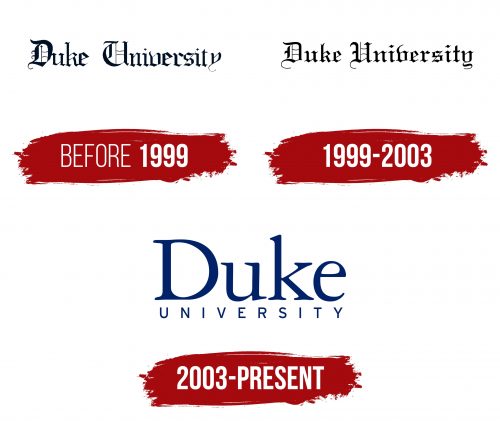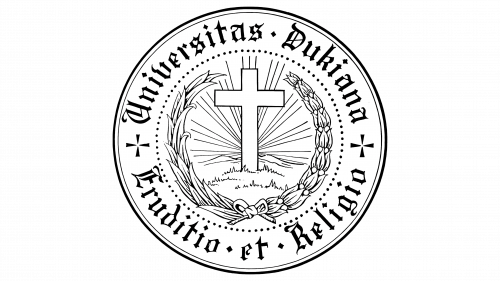The Duke University logo deeply connects to its rich history and two centuries of development. The emblem symbolizes pride in the path taken and respect for the benefactors whose generous support played a key role in establishing and expanding the university’s educational and research capabilities. The symbol preserves the memory of significant contributions to advance knowledge and ensure the region’s prosperity, highlighting the importance of heritage and the ongoing pursuit of academic excellence.
Duke University: Brand overview
In 1838, a group of Methodists and Quakers formed a subscription to construct a school in Trinity, North Carolina, marking the beginning of Duke University’s history. Originally known as Brown’s Schoolhouse, this institution served as the model for Duke University.
After receiving official recognition from North Carolina in 1841, the school changed its name to Union Institute Academy. This institution provided teacher training and basic education to the local populace.
A major shift occurred in 1851 when Normal College, then Union Institute Academy, was granted the authority to award degrees. This change reflected the institution’s expanding role in preparing teachers for the area.
The establishment renamed itself as Trinity College in 1859. This shift occurred concurrently with the college falling under the jurisdiction of the Methodist Church, a development that would have a major impact on it in the following decades.
A significant turning point in the college’s history occurred in 1892. Thanks to the generous donation of property and financial backing from affluent tobacco industry executives Julian S. Carr and Washington Duke, the institution relocated from Trinity to Durham, North Carolina.
Washington Duke gave a sizable gift to the college in 1896, but only under the stipulation that it start admitting women on an equal footing with males. As a result of this decision, Trinity College became one of the first universities in the South to offer coeducation.
1924 was a pivotal year in the organization’s history. Washington Duke’s son, James B. Duke, founded The Duke Endowment, a philanthropic organization that made a sizable donation to the college. As a token of appreciation for this donation, the university was the college’s new name.
This marked the start of the institution’s explosive growth. The newly constructed campus, which opened in 1930, symbolized the university’s neo-Gothic architecture. The magnificent Duke Chapel, which still represents the institution, was part of this architectural complex known as West Campus.
The institution started to significantly expand its research programs in the 1930s. The School of Medicine, the School of Law, and the School of Forestry and Environmental Studies were among the new institutions and schools that were founded.
The establishment expanded substantially in the 1940s and 1950s, consolidating its standing as a preeminent research university, particularly in medicine and the natural sciences.
One of the first significant universities in the South to start the racial integration process was the institution in the 1960s. Even though it was a difficult period, the establishment persisted in building a more welcoming environment.
The 1970s and 1980s saw further growth of academic programs and research capacities. The Institute of Political Science and the Center for the Study of Aging were two new centers and institutions founded during this time.
The university’s global reach increased significantly during the 1990s. The establishment started aggressively establishing relationships and exchange programs with universities abroad.
During the 2000s, the institution maintained its standing as one of the top research universities in the world. Large sums of money were spent on new research facilities, laboratories, and other scientific infrastructure.
The decade of the 2010s saw the institution’s global reach grow. In 2014, Duke Kunshan University opened its doors in China as a joint venture with Wuhan University.
To greatly enhance research and instruction in science, technology, engineering, and mathematics (STEM), the university initiated the expansive “Duke Science and Technology” initiative in 2020. This effort includes modernizing laboratories, establishing research centers, and hiring additional academics.
The inauguration of the new Rubenstein Arts Center in 2021 greatly increased the university’s capacity for arts education and cultural events.
In 2022, the institution expanded its machine learning and artificial intelligence curriculum by establishing AI Health, an interdisciplinary institute devoted to using AI in healthcare.
Additionally, the establishment kept growing its international reach. In 2022, Duke Kunshan University declared that it would expand its programs in China and intended to create more foreign learning facilities.
The institution started a new program in 2023 to encourage entrepreneurship among its students and alumni. The goal includes expanding its innovation and entrepreneurship programs and establishing a business incubator.
The establishment also enhanced its offerings in sustainable development and climate change by establishing a new multidisciplinary center that unites scientists from different scientific disciplines.
The institution maintained its investment in the growth of its medical school and healthcare system during this time, solidifying its standing as one of the top medical research facilities in the country.
The university launched several programs to foster a more equal learning environment and pay close attention to diversity and inclusion concerns.
In the field of education, the institution kept introducing cutting-edge teaching strategies, such as growing its online curriculum and integrating augmented and virtual reality into the classroom.
Meaning and History
What is Duke University?
The university, located in Durham, North Carolina, is a renowned private research university. It is known for its academic brilliance, offering various undergraduate and graduate programs in arts and sciences, engineering, business, law, medicine, theology, and other fields. The university is renowned for its emphasis on global engagement, interdisciplinary studies, and scholarly inquiry. The campus is renowned for its stunning grounds, which include the recognizable Duke Chapel and Gothic architecture. State-of-the-art libraries and cutting-edge research centers are just two of the university’s top-notch amenities. The university attracts top applicants worldwide through an extremely selective admissions process. It maintains a vibrant community on campus with a strong commitment to athletics, especially its successful basketball program.
Before 1999
The university’s first logo was created in Old English font, emphasizing its connection to traditions. The institution’s founders were Methodists and Quakers—representatives of Christian movements that originated in England and were brought to the United States by missionaries and settlers. These communities preserved elements of their native culture, reflected in the lettering style. The first letters are highlighted in an especially bold and wide font, giving the inscription significance. The university was named after benefactor Washington Duke, whose family established a fund to support Trinity College, which was renamed in his honor in 1924.
1999 – 2003
The logo underwent minor changes, maintaining the overall writing style. The increased spacing between the characters added a sense of lightness to the inscription, improving readability. The glyphs of all the letters are of equal width, giving the emblem a harmonious and balanced appearance.
2003 – today
The modern Duke logo reflects the pursuit of scientific achievement and academic excellence. It is designed in a restrained and elegant style, matching the institution’s status and reputation.
The central element is the university’s name, rendered in large blue serif font. This font gives the entire mark a classic and academic look, emphasizing the long history and traditions of the institution. The blue color is associated with wisdom, intelligence, and trust, perfectly aligning with the university’s mission focused on science and research.
The word “University” is positioned below and written in a smaller, even sans-serif font. This font makes the logo compact, concise, and modern while remaining easily recognizable and memorable.
The emblem conveys the university’s spirit of academic excellence and symbolizes its leading role in education and scientific research.
The Seal
The university’s seal reflects its deep religious roots and traditions. Its design is strict and reverent, emphasizing the importance of spiritual values in the educational process.
The edges of the seal feature the university’s Latin name, Universitas Dukiana, and its motto, Eruditio et Religio, which translates as “Knowledge and Faith.” This motto reflects the university’s pursuit of a harmonious combination of academic knowledge and religious beliefs.
The central element of the seal is the Cross of Christ, symbolizing faith and spiritual salvation. The cross is surrounded by a wreath of victory, representing the triumph of resurrection and life over death. This symbolism echoes the university’s Methodist roots, highlighting the significance of Christian values in its mission.
The seal’s font is in Old English, giving it a sense of tradition and connection to history. The overall tone and design of the seal create a sense of respect for religious heritage, making it an important element of Duke University’s identity.








